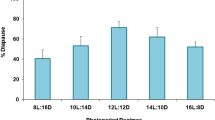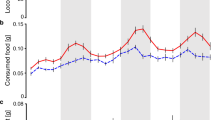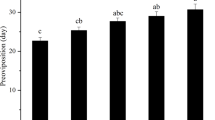Abstract
Anthrenus verbasci (L.) (Col. Dermestidae) has a two-year life-cycle (semivoltine) under outdoor temperature conditions in southern England, spending the first winter as a young larva and the second as a fully grown larva1. Under constant conditions in the laboratory larvæ may be either uni- or semivoltine according to temperature. The percentage of larvæ with a univoltine life-cycle increases from 0 at 15° C. to 100 at 25° C. The larvæ have been shown to possess an endogenous and persistent rhythm controlling the onset of diapause2. Each cycle of the rhythm consists of a period of active growth (with moulting and/or pupation) followed by diapause. Under constant conditions the length of the cycle is about 44 weeks, but this is extended to an annual cycle, under outdoor conditions, by the insertion of a period of dormancy after the completion of diapause.
This is a preview of subscription content, access via your institution
Access options
Subscribe to this journal
Receive 51 print issues and online access
$199.00 per year
only $3.90 per issue
Buy this article
- Purchase on Springer Link
- Instant access to full article PDF
Prices may be subject to local taxes which are calculated during checkout
Similar content being viewed by others
References
Blake, G. M., Bull. Ent. Res., 49 (4), 751 (1958).
Blake, G. M., Nature, 183, 126 (1959).
Corbet, P. S., Nature, 175, 338 (1955).
Author information
Authors and Affiliations
Rights and permissions
About this article
Cite this article
BLAKE, G. Decreasing Photoperiod inhibiting Metamorphosis in an Insect. Nature 188, 168–169 (1960). https://doi.org/10.1038/188168a0
Issue Date:
DOI: https://doi.org/10.1038/188168a0
This article is cited by
-
Effects of temperature on the development and circannual control of pupation in the carpenter moth, Cossus insularis (Lepidoptera: Cossidae), reared on an artificial diet
Applied Entomology and Zoology (2017)
-
Photoperiodic control of larval development in the semivoltine cockroach Periplaneta japonica (Blattidae: Dictyoptera)
Ecological Research (1995)
-
Circannuale Rhythmen bei Tieren und ihre photoperiodische Synchronisation
Naturwissenschaften (1981)
-
Quantitative Response to Daylength during Diapause in Insects
Nature (1973)
-
Die abh�ngigkeit der diapause von der photoperiodizit�t bei Tetrix Undulata (sow.) (saltatoria, tetrigidae) (mit beitr�gen zur biologie und morphologie dieser art)
Zeitschrift f�r Morphologie und �kologie der Tiere (1964)
Comments
By submitting a comment you agree to abide by our Terms and Community Guidelines. If you find something abusive or that does not comply with our terms or guidelines please flag it as inappropriate.



